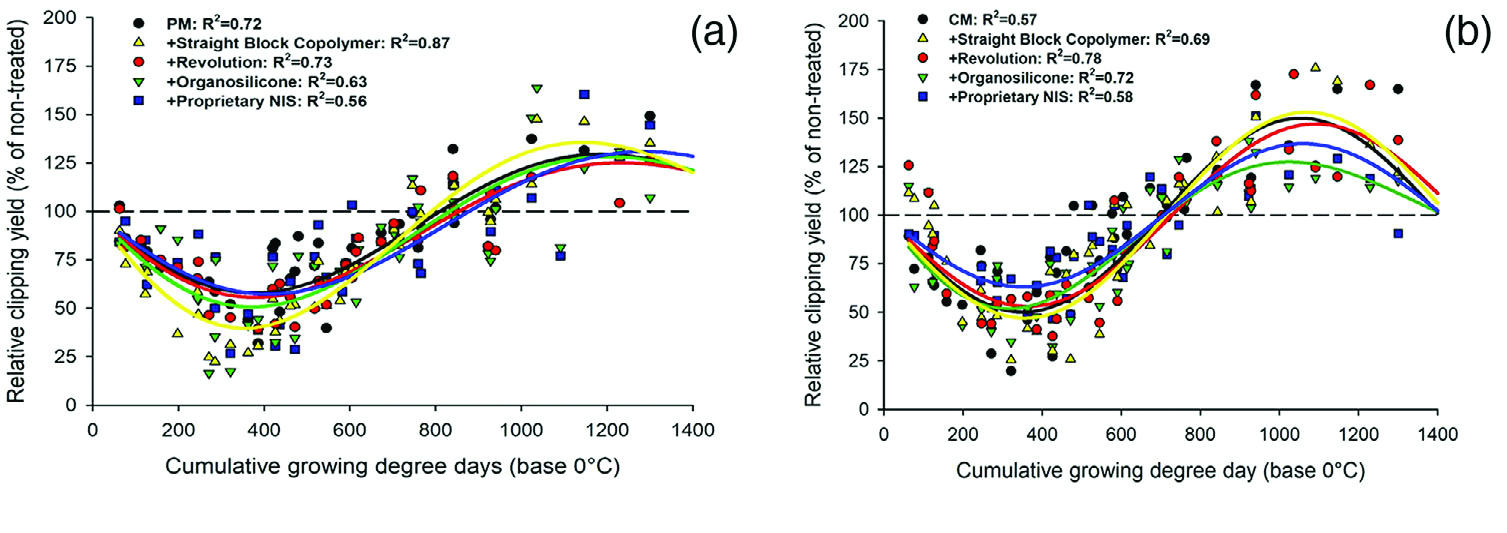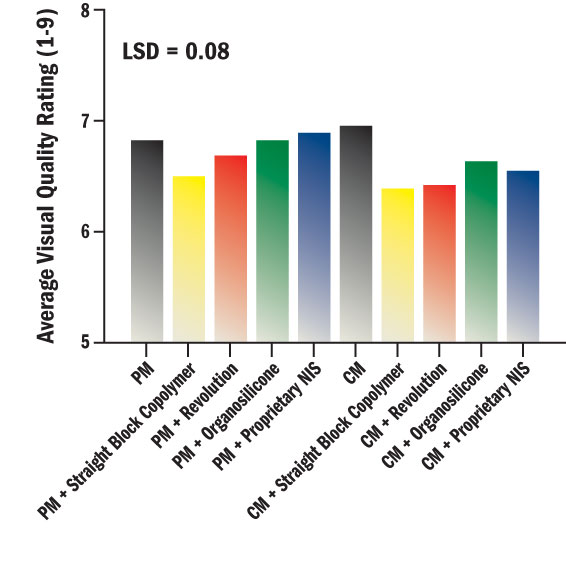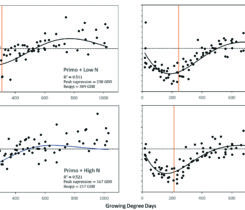How surfactants influence PGR performance and turfgrass quality
Primo MAXX [trinexapacethyl (PM), Syngenta] and Cutless MEC [flurprimidol (CM), SePRO Co.] are two commercial PGRs in the turfgrass industry used to suppress clipping yield production (2). Temperature inversely correlates to the duration of clipping yield suppression following a PGR application. Superintendents can estimate reapplication intervals from growing degree day (GDD) reapplication thresholds (5). There is interest in lengthening these GDD intervals by including tank-mixed adjuvants with PGR applications.
A previous study showed that mixing a surfactant with PM will increase cover and decreasing irrigation in bermudagrass (Cynodon dactylon) showed that combining a surfactant with an older formulation of PM called Primo increases the uptake and absorption of the active ingredient (3,8,9).
PM replaced the original Primo formulation in 1999. This new formulation uses a different inert package to improve PM uptake and ease of use. The product label states that PM should not be tank-mixed with herbicide or wetting agents (7).
Primo MAXX is foliar-absorbed, whereas CM is root-absorbed. It is unknown whether adding additional surfactants to this new formulation will enhance or decrease the PGR’s efficacy. It is unclear whether tank-mixed surfactants will improve the effectiveness of root-absorbed PGRs. The objective of this research was to determine whether different surfactants enhanced the performance of PM or CM.
Site Characteristics and Experimental Design
We conducted field research from June 19 to Oct. 30, 2017, and from July 9 to Oct. 30, 2018, on a creeping bentgrass fairway at the University of Nebraska- Lincoln East Campus Turfgrass Plots. Crews mowed the site three times weekly and irrigated to a calculated 80 percent of potential evapotranspiration (1). Every two weeks, we fertilized the plot with 0.2 pounds N per 1,000 ft.-2 (46–0–0, N–P–K). We withheld soil surfactants, demethylation inhibiting fungicides and sand topdressings throughout the study.

Table 1
The experimental design was completely randomized with a minimum of three replicates. We used different control treatments to assess the PGR plus surfactant performance. They included PM or CM applied alone to study the impact of the surfactant/ PGR combinations. There also were five non-treated control plots to calculate the relative clipping yield for all treatments.
We arranged treatments in a completely randomized design with a 2 × 4 factorial of two PGRs and four surfactants (Table 1). The initial applications occurred on June 6, 2017, and July 9, 2018. Crews made the second applications on Aug. 31, 2017, and
Sept. 10, 2018 (Table 2). We used a 5-foot-wide three-nozzle (Teejet AI8006, TeeJet Technologies) boom backpack sprayer to make the applications. We calibrated the sprayer to deliver a spray carrier volume of 85 gallon acre-1 at 40 lb. in.-2. We hand-watered in Cutless MEC with 0.5 inches of water applied by a hose fitted with a flow meter (Table 1).

Table 2
The team collected clippings on Monday and Friday from 0 to 850 GDD (base 0 degrees C) after treatment application and once weekly after 850 GDD. We collected, dried and weighed clippings (5). We performed sine wave regression of clipping yield over time to determine the amplitude and period of the PGR response model in Sigma Plot Version 14 (Systat Software) (6). We analyzed data from each run and each year separately. Individual runs for the treatments were not statistically different, and we pooled them to increase statistical power (data not shown).
Our team collected visual quality using the National Turfgrass Evaluation Program 1 to 9 rating system, with a score of 6 or greater being acceptable (4). We averaged quality ratings of the four runs by JMP Version 13 (SAS Institute).

Fig 1
Two Surfactants Enhanced Primo Maxx Suppression

Table 3
The addition of the surfactant to PM did not significantly impact the duration of clipping yield suppression compared with PM applied alone (Table 3, Figure 1). There were differences in the amount of suppression between the PM applied alone compared to the straight block co-polymer + PM and organo- silicone + PM treatments. Straight block co-polymer + PM suppressed yield by 63 percent, whereas the PM applied alone suppressed yield by only 42 percent. Organosilicone + PM suppressed clipping yield by 52 percent.
Past research indicated the application rate influences the amount of suppression but not the duration of clipping yield suppression (5). Organosilicone adjuvants could increase PM absorption and suppress clipping yield (3). The increased clipping yield suppression with these surfactants without increased suppression duration could suggest that the straight block co-polymer and organosilicone surfactants increased PM uptake.
The proprietary nonionic surfactant (NIS) + CM reduced suppression compared to CM applied alone (Figure 1). The NIS + CM treatment had a maximum clipping yield suppression of 38 percent (Figure 1). The CM control had 49 percent suppression. We saw no significant differences in growth suppression duration between the CM treatments (data not shown). Mixing a surfactant with CM may have limited effects because CM is root-absorbed.
The overall visual quality ratings ranged from 6.0 to 6.8 among all treatments (Figure 2). The addition of surfactants to PM and CM did not result in significant or unacceptable phytotoxicity. The PM control and the PM with surfactants had visual quality ratings of 6.6 to 6.8. Mixing PM with a surfactant did not reduce turfgrass quality to unacceptable levels. The PM + straight block co-polymer reduced the turf quality rating compared to the non-treated control.

Fig 2
The application of CM alone had a similar quality to all the PM treatments. However, the addition of the different surfactants to PM resulted in lower average quality than the CM control (Figure 2). The magnitude of the decline in visual quality rating was less than one-half of a quality unit, and the mean visual quality rating was never <6.0.
None of the surfactant treatments increased the duration of PGR growth suppression for both PM and CM. Any of the surfactant treatments did not increase Cutless MEC suppression. Adding a surfactant to PM sometimes enhanced clipping yield suppression but can also reduce turfgrass quality rating. Increasing the PM application rate can also increase clipping yield suppression. Adding surfactants to CM, a root-absorbed PGR did not enhance clipping yield suppression or lengthen the products’ duration. The surfactants slightly reduced turfgrass quality. These results do not support the addition of tank-mixed surfactants to CM.












